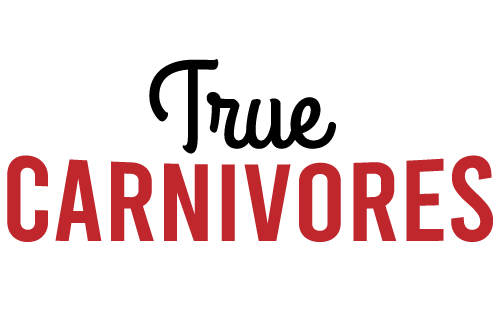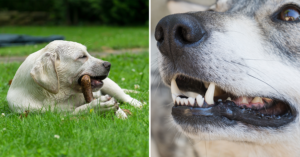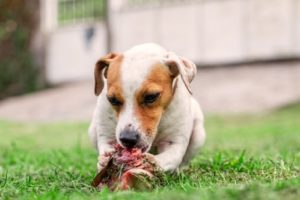
- Unparalleled toothbrush, cleans your pet’s teeth like no other
- Great mental and physical activity for your pet, after the meat is gone, the bones can last for weeks
- Mineral rich and especially dense in calcium and phosphorus
- Removes plaque and promotes gum and dental health
- Many bones have glucosamine, which aids in joint health. Some bones with high glucosamine content include chicken wing tips, feet, and carcasses.
- Can be used as a meal replacement
One of the main factors involved in choosing an appropriate chew is to navigate the question of how hard or soft their bone should be.
Harder, denser bones and chews are great for gently scraping away plaque and softer chews help clean the hard to reach places. Most puppies and adult dogs with good oral health have the most flexibility in chew options.
Dogs with poorer oral health (gingivitis, bleeding gums, worn down teeth or history of cracking teeth, some senior dogs) might be best with softer chews. Dogs who have damaged teeth are at risk of causing further issues if their chews are too hard. This includes aggressive chewers who are more concerned about having a good time than their teeth!
Harder chews are longer lasting and clean teeth well, but we need to keep in mind long term chewing on these, especially for over enthusiastic chewers, could lead to damaged teeth. Therefore, alternating between softer and harder chews is the most beneficial! Dogs still get the enjoyment and benefits of chewing while reducing their risk of dental injuries when alternating.
Some great soft chew options include chicken, duck and turkey necks, whole quail, lamb and pork necks meaty tails, bully sticks, and beef tendons.
Toothbrush/ Meal Replacement bones
- Bones with fibrous meat are a great meal replacement and also act like a toothbrush for your dog.
- Some examples of these bones include necks (chicken, duck, turkey, pork, lamb, beef), meaty ribs, tails, whole quail, whole fish
- These bones have a very high meat to bone ratio, can be used as a nutritious snack, or in place of your pet’s regular meal.
Recreational Bones
- Some examples include knuckles, femurs, antlers, yak chews, horns, hooves
- Due to their shape, these bones are suited for mental and physical stimulation, and can provide hours of chewing action.
- Recreational bones are a great option for the gentle chewer. If your dog is an excited chewer, these bones can sometimes risk tooth breakage.
Our dogs never fail to surprise us. That same rule goes for anything that goes into a dog’s mouth, including bones and chews. We always recommend that you monitor your dog while they are chewing in case they swallow something that too big for digestion.
Keep in mind that bigger bones are always safer. We generally recommend that you try out a bone approximately the size of your dog’s head in order to minimize the chances of them accidentally swallowing the bone. This will also give your dog the opportunity to learn how to chew properly before they get into the habit of swallowing their bones.
Given time and experience you will learn what “style” of chewer your dog is. When you are more familiar with what type of chewer your dog is you may feel comfortable to leave them unsupervised for periods of time, but we always leave that discretion to you. You know your dog best! Use the guidelines we suggest for choosing the right bone for your dog to decide what the safest choices are for them.
Your dog may choose to not consume their whole bone in one sitting, or you may decide to take it away before they do. That’s okay! Here are a few things to keep in mind if they don’t finish their whole bone.
- Bones themselves don’t spoil, meat and marrow can.
- If there is no meat or marrow remaining on a recreational bone, then it is okay to leave out for your dog to enjoy at their leisure (or until you get tired or tripping over it!)
- If a bone still has meat or marrow remaining after the first day your dog has been enjoying their bone it can go in the fridge overnight. Do not refreeze a thawed bone, it is not considered food safe to refreeze previously thawed meat. You can offer the bone again the next day after it has been in the fridge overnight. If the remaining meat and marrow has been consumed, great! They can continue to chew the bone as long as you would like to make it available to them. If there is still meat and marrow remaining by the end of day two, you can either throw away the bone or remove any meat or marrow yourself so your dog can continue to chew the bone later.
- Put down a towel. This can help contain any mess they make. When they are done you can throw the towel in the washing machine.
- Offer a bone in a place where there is no carpet such as your kitchen or they can chew it outside. A patio is also an excellent space for bone chewing.
- If dog likes to roam the house with their bone, put them on their leash so they don’t carry it off somewhere.
- Watch their poops after they have had a bone. Too much calcium from bone can make their poops white, hard, chalky looking, and harder to pass. Too much marrow can make their poops softer than usual. These are both okay, as long as their poops return to normal after a couple of days.
These tips and tricks are intended as a guideline to help you decide when choosing the best chews for your dog. This is based on years of experience with our own dogs and helping hundreds of others. Saying that, you will always know what is best for your dog, you spend more time with your dog than anyone else and you will know what will best suit your dog’s behaviour and health.
If you are ever unsure, feel free to contact us. We will always do our best to assist you in learning.
The values below represent the estimated percentage of bone:
- Chicken back: 44%
- Chicken neck with skin: 36%
- Chicken neck without skin: 75%
- Chicken foot: 60%
- Chicken leg quarter: 27%
- Chicken head: 75%
- Whole chicken: 31%
- Chicken drum stick: 33%
- Chicken bone-in breast: 20%
- Chicken thigh: 21%
- Chicken ribcage: 80%
- Chicken wing: 46%
- Chicken carcass: 60%
- Cornish hen: 39%
- Duck neck: 50%
- Duck foot: 60%
- Duck head: 75%
- Duck wing: 39%
- Duck frame: 75-80%
- Duck leg: 34%
- Duck breast: 15%
- Whole duck: 28%
- Turkey neck: 42%
- Turkey foot: 60%
- Turkey head: 75%
- Turkey bone-in breast: 10%
- Turkey wing: 33%
- Turkey leg: 38%
- Turkey back: 50%
- Turkey whole: 21%
- Turkey thigh: 20%
- Turkey tail: 10%
- Pork feet: 30%
- Pork ribs: 30-40%
- Pork tail: 30%
- Pork neck: 50%
- Whole prey, with fur: 10%
- Whole rabbit: 28%
- Rabbit head: 75%
- Rabbit front leg: 15%
- Rabbit hind leg: 14%
- Rabbit spine/back: 15%
- Rabbit front quarter: 23%
- Rabbit hindquarter: 17%
- Lamb ribs: 27%
- Lamb neck 32%
- Lamb chop: 15%
- Whole quail: 10%
- Guinea hen: 17%
- Pigeon: 23%
- Wild duck: 38%
- Whole pheasant: 14%
- Cornish hen: 39%
- Whole goose: 19%
- Whole dove: 23%
- Whole mouse: 5%
- Whole rat: 5%
- Guinea pig: 10%















